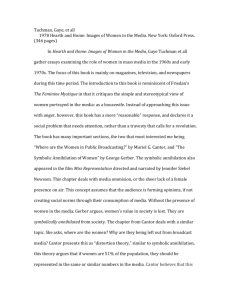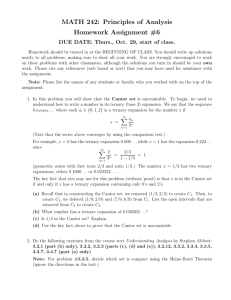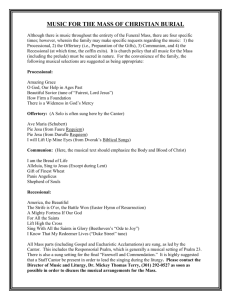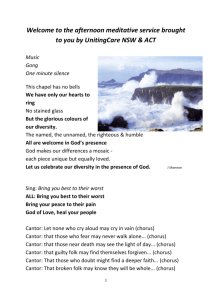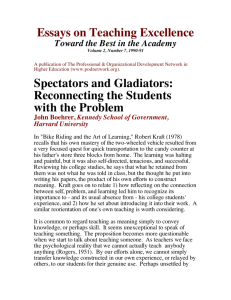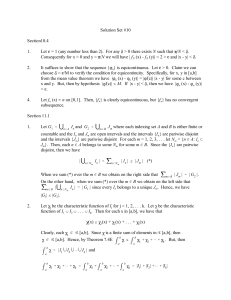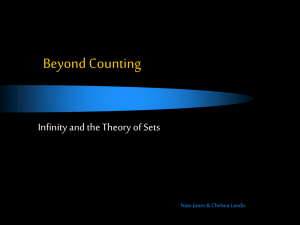l-shift
advertisement
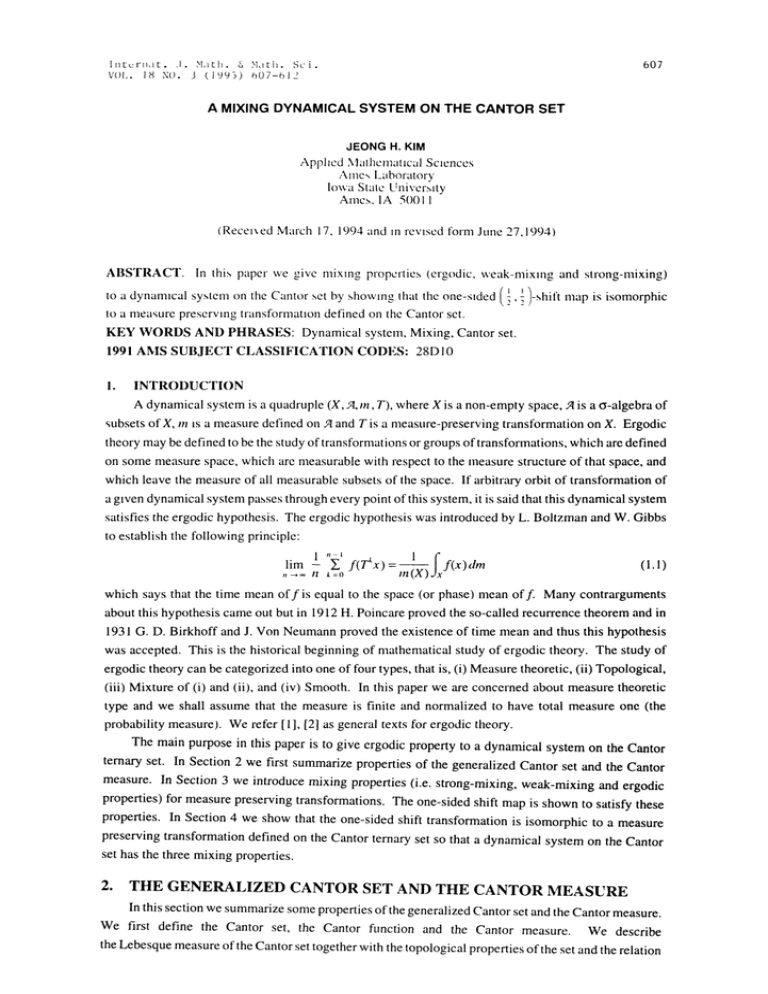
607
V()I..
1 N(),
(i99) f07-(12
A MIXING DYNAMICAL SYSTEM ON THE CANTOR SET
JEONG H. KIM
Applied Mathematical Scmnces
AInc, Laboratory
Iowa Stale University
Ames, IA 50011
(Recexed March 17, 1994 and n revised form June 27,1994)
ABSTRACT. In this paper we give mixing properties (ergodic, weak-nixng and strong-mixing)
.(! l-shift map is isomorphic
dynamical system on the Cantor set by showtn,, that the one-sided
Cantor set.
KEY WORDS AND PHRASES: Dynamical system, Mixing, Cantor set.
1991 AMS SUBJECT CLASSIFICATION CODES: 28D10
to a
to a measure preserving transformation defined on the
.
INTRODUCTION
A dynamical system is a quadruple (X,.,q, tn, T), where X is a non-empty space, is a o-algebra of
subsets of X, m s a measure defined on ..q and T is a measure-preserving transformation on X. Ergodic
theory may be defined to be the study of transformations or groups of transformations, which are defined
on some measure space, which are measurable with respect to the measure structure of that space, and
which leave the measure of all measurable subsets of the space. If arbitrary orbit of transformation of
a gven dynamical system passes through every point of this system, it is said that this dynamical system
satisfies the ergodic hypothesis. The ergodic hypothesis was introduced by L. Boltzman and W. Gibbs
1.
to establish the following principle:
lim
1" f(Tx
II
=0
fx
f(x) tbn
off is equal to the space (or phase) mean off. Many contrarguments
about this hypothesis came out but in 1912 H. Poincare proved the so-called recurrence theorem and in
1931 G. D. Birkhoff and J. Von Neumann proved the existence of time mean and thus this hypothesis
was accepted. This is the historical beginning of mathematical study of ergodic theory. The study of
ergodic theory can be categorized into one of four types, that is, (i) Measure theoretic, (ii) Topological,
(iii) Mixture of (i) and (ii), and (iv) Smooth. In this paper we are concerned about measure theoretic
type and we shall assume that the measure is finite and normalized to have total measure one (the
probability measure). We refer [1], [2] as general texts for ergodic theory.
The main purpose in this paper is to give ergodic property to a dynamical system on the
Cantor
ternary set. In Section 2 we first summarize properties of the generalized Cantor set and the Cantor
measure. In Section 3 we introduce mixing properties (i.e. strong-mixing, weak-mixing and
ergodic
properties) for measure preserving transformations. The one-sided shift map is shown to satisfy these
properties. In Section 4 we show that the one-sided shift transformation is isomorphic to a measure
preserving transformation defined on the Cantor ternary set so that a dynamical system on the Cantor
set has the three mixing properties.
which says that the time mean
2. THE GENERALIZED CANTOR SET AND THE CANTOR MEASURE
In this section we summarize some properties of the generalized Cantor set and the Cantor measure.
We first define the Cantor set, the Cantor function and the Cantor measure. We describe
the Lebesque measure of the Cantor set together with the topological properties of the set and the relation
between lhe Cantor measure and the kebesque mea,,ure otlhe et. The Cantor set s knon to have the
same cardnalty as the inlerval [0,1]. Fnally n ths see[ion we present the ternary rcpresenlation of
Cantor’s mddle third
DEFINITION 2.1. Le n,n
n
be a sequence of real numbers such thai
< tiC <
Ir
We define the generalized Cantor set denoted by C(,
or briefly
C) as follows: We remove the open interval of size L about the mddle pon fion he nlerval [0,1].
every k
1,2
Then remove the open interval of size
,
(1-1
.
intervals. After k removals, there are 2 closed intervals left denoted by
and at the k +
,
about the middle of each of the two remaining closed
step we remove the open intervals of size
1,2,3
Ct(tt), j
2
(1-)abouthecentcrofthese
intervals. The generalized Cantor set C is defined to be the complement in the interval [0,1] of he
union of these open intervals, i.e.,
21
C=
w
C(n),
(2.1)
=1 j=l
which depends on the choice of the sequence n,n2
n
DEFINITION 2.2. We define the Cantor function F(t),
, ,
[0,1 ], by setting it equal to 1/2 on the
first interval removed, 1/2 and 3/2 on the two intervals removed at the second step, 1/2 3/2 5/3 and
7/2 on the third removal, etc. The values are chosen in the obvious way so that the Ihnction F is
monotone non-decreasing on [0,1 (F is extended to [0,1] by the coninuily).
DEFINITION 2.3. The Cantor measure F on [0,1] is defined by
(2.2)
laF([O,t))= F(t
where F(t) is the Cantor function.
We note that the above r becomes a Borel measure by the following argument: If we let A be the
..
.
semialgebra consisting of all intervals of the form [a ,b), 0 < a < b _< 1, and set lar([a, b ))
then I.tr satisfies the following two conditions:
1.
l.tF(B)= ’,’:tl.tF(B,) for any finite disjoint union B(=w’,’=B,) of B,’s in
2.
tF(B) <-- Y= F(B,) for any countable disjoint union B (= w7= B,) of B,’ s in
F(b
F(a ),
Then lar admits a unique extension to a measure on the algebra generated by and thus, from CaraHence we have
theodo extension theorem, r can extended to a -algebra containing
an extension of
to a Borel measure.
In the following we describe the topological stcture of the generalized Cantor set C d the
relation between the Cantor measure and the Lebesque measure of the Cantor set.
2.
3.
There is a bijection map between the Cantor set C and the inteal [0,1].
The Ctor set C is always nowhere dense.
The Cantor set C is a perfect set.
4.
The Lebesque measure of the Cantor set C is given by the infinite product
5.
The Ctor measure g of the Cantor set C is absolutely continuous with respect to the besque
1.
-.
measure of the set if 2=
6.
The Cantor measure ge is mutually singular with respect to the Lebesque measure if
nk
If n, is a fixed positive rational number (constant disection ratio) for all k
1,2
then we can
,"II \ Xt, IjY,’,,A,II (:.\I
,q .’-:, I.I
t)X
IIII.
009
(,,\N L’t)R ,’-:,I.
ohtaln the concrete rcpre<,cniatllln of the Cailor sot (of [3l). if in particular #ix 3 for all k= !,2
the tlol’lllillOll of the gCllOlall/cd CalllOr sol C, lhcll c (_" iI aild oi11 if h,ls ti IClllary
icpl-c,OlllilliOll t)f the l)llll
called the Carll(li lciilary
")
,;
sol
whore a,, e {(), I} for all
{)i
"
#l
In this
case, Ihc
(-’alllOi"s middle third sol and the (’alllOr ftliWIIOll
P" on
(’
I,
given
hv
_kL
F
3.
DYNAMICAL SYSTEM AND THE ONE-SIDED StlIFT
TRANSFORMATION
In this section we define a nicasurc preserving translbrmation and a dynamical system in terms of
lhs transformation. We introduc tho three kinds of mtxino properti (t e. erodic, wak-mixn and
strong-mixing) of a measure prsrvin transformalion. Th one-sided shift map is shown to b a
transformation which has all of these thre proprtos.
DEFINITION 3.1. Suppose th triplos (X,.q,m) and (X,,m) are probability spaces. Thn
(a)
(h)
T’X
T’X
-::
:.
X is measurabl if T
X is masur-prsrvin if T is measurabl and m,(T-’(B))= m() for all B
.
Th lllowing thorom is well known in masur theory [4]. It provides th sufficient condition
lr the map T to be measure-prsrvin in trms of gnoratin algebra.
TEEOgE 3.1.
.
,:
Suppos (Xt,,m) and (X:,.,m) ar probability spaces. Let
which generates th -alebra
If T is a map
m(T-’()) m(), thn T is measure-prosorvin.
Sinc wo wish to study the iteration
such that, for any B
be an alebra
t(B) t
and
T" of the transformation T, w shall dal with the identical
case (X,t,m)= (X,,m). A probability spac (X,,m) together with a measure-preserving transformation T dfins a dynamical sstem (X, m, T). Th above Theorem 3. shows that whthr a
given transformation is masur-prserving or not is determined only by the knowldge of an algebra
generating the -algebra
In th following we defin the thre mixing properties for a dynamical system. In the theory of
dynamical systems, mixing is the property of indecomposibility of a dynamical system into nontrivial
invariant subsets.
DEFINITION 3.2. (X,,m, T) is a dynamical system.
(a) T" X
X is ergodi if for arbitra A, B
II
(b) T’X
.-)
m(AB)m(A)m(B)
X is weak-mixing if for arbitrary A, B
Im(T-A cB)
as
.
=0
m(A)m(B)l
(c) T" X ---> X is strong-mixing if for arbitrary A, B
--)
0
(3.1)
n
as
n
---)
(3.2)
.,q
m(T-"A B) --) m(A) re(B) as
REMARK. (i) It can be shown [1] that T’X X
n
---)
(3.3)
is ergodic if and only if, for arbitrary
A e T-(A) (A) implies that eitherm (A) Oorm(A) 1. (ii) Forany sequence
{a,,} ofreal numbers,
a, 0 implies
1 a,l 0 which in turn implies Y ak 0, respectively, as n ---) ,,o. Therefore,
"strong-mixing" implies "weak-mixing" and "weak-mixing" implies "ergodic."
,:
-,
.I.H. KIN
610
.,,
Like measure-preserving property, mixing property determined by the knowledge of generating
algebra. From ths we can prove that the one-sided shift transformation defined by the following is
strong-mixing and .so v,’eak-mxng and ergodc.
n and p, be the measure corresponding to each e Y such
DEFINITION 3.3. I..et Y 1,2
that
Y_.’,’: p,
1. Let us define the nfinte product space
X=
I-I X,, X,=Y
(3.4)
I--l
X defined by
equipped with the direct product measure m. Then the map S :X
x
S (x, x_
is called the one-sided (p, P2
(3.5)
r,
(x2,x
p,,)-.,,hift transformation.
The one-sided (p, P2
p,,)-shift transformation S is measure-preserving and thus the quadruple
(X,yl, m,S) is a dynamical system.
THEOREM 3.2. The one-sided (p, P2
p,,)-shift transformation S is strong-mixing.
PROOF. We call the set ’__ {A
FI A,, A,
X A
Y for all > k measurable rectangles
in the probability space X. The set of all measurable rectangles in the space X creates a generating
algebra. We denote it by ’. From the above remark, we need to show the strong-mixing property for
this algebra. For arbitrary A, B e yl", there exists a positive p such that if k > p, then
B) m (T-A )m (B)
n (T-tA
tn (A
(3.6)
m (B)
and thus we have
tn(T-A B)
r/
k=0
which converges to m (A)tn (B)as n
4.
--4 oo.
n
m(T-AB)+
k=0
p
1--- m(A)m(B)
n
(3.7)
The theorem, therefore, is proved.
ISOMORPHISM OF MEASURE-PRESERVING TRANSFORMATIONS
The content of this section is our main result. In previous section, we show that the one-sided
(p, p
p,,)-shift transformation is ergodic, weak-mixing and strong-mixing. In this section, we define
a measure-preserving transformation on the Cantor measure space, i.e., the Cantor ternary set, and then
transformation defined on the
show that this transformation is isomorphic to the one-sided 5,
product space X (see Definition 3.3). The Cantor measure space together with the one-sided shift
transformation, therefore, becomes a dynamical system having the three mixing properties.
( )-shift
THEOREM 4.1. Suppose that (C, Y,, lad is a probability space, where C is the Cantor ternary set,
Y-is a ’-algebra generated by finite disjoint unions of sets of the form [a, b)
is the Cantor measure. Then the function T C--> C defined by
T
2,,Z,
=2,Y_.,, --,
a,,
{0,1}
C, 0 < a < b < 1, and 1.F
(4.1)
is a measure-preserving transformation.
PROOF. We can use the form [a, b
Cinstead of [a, b) C as a generating algebra, denoted by
y’, since the latter is a countable union of the sets of the former form.
we can assume that a, b
C’, let
a
a=2,Y_.,-/,
_,_
b=2,,=, b
Also, without loss of generality,
a,,,b,, 10,1}.
(4.2)
HIXING DYNANICAL SYSTEM ON THE CANTOR SET
611
We shall show first the equality
T-’([a,blC)=
’-
3
c
3
(4.3)
which is a disjoint union because b < a + 2. Then obviously the right-hand side of (4.3) belongs to
sothat T becomes measurable. Now lctx e [a,b]Cwithx 2Y,:
Then a,, < x,, < b,, up to n
e’"
for some "o and
T-’ (x) " Y,7=
’"-.__! where is either 0 or
xo
I/"
no
and thus T-(x) belongs to the right side
For the reverse direction of subset, let y e .7,7 C with y 2 Y., v," Then y =0 and
a,,_<y,,<b,,_t up to no for some n0 and thus a<T(y)<b. Similarly, the set ----,-q- oC
of (4.3)
[,,+2 ,,+2]
can be shown to be a subset of T-([a,b ]cn C). Therefore the equality (4.3) is established. Next we will
show that l&(T-*([a,b 1 C))
g-([a, b ] C).
b
a
,Z 2,-7-,,Z 2’-;
=F(b)-F(a).
The theorem, therefore, is proved.
12]
DEFINITION 4.1. Suppose that the quadruples (X,A,,m,,T) and (X:,.a2,,n2,T2) are two
dynamical systems. Then we say that TI is isomorphic to
and ,n(M)= with property that
m(M,)
T,(M)
M
T:,(M:)
T2 if there exist M e
.,
and
M e .2 with
M
(4.4)
and there exists an invertible measure-preserving transformation O’M
----)
M., such that
qr, T:
on M.
THEOREM 4.2. Suppose the quadruples (X,
.,
m, S) and (C,
(4.5)
,,
gF, T) are the dynamical systems
l-I ’_- X,, X, {0, }.
defined in Definition 3.3 and Theorem 4.1, respectively, where X
Then S is
isomorphic to T.
PROOF. To define an appropriate map @, we first define the following notation: Let
be an arbitrary element in X, i.e., x,, 0 or for any n 1,2 K(x) denotes the
x,
(x,x2
closed interval of the left side of the first removed open interval ?,
it if x,
.
if x,
0; that of the right side of
1. K2(x,,x) denotes the closed interval of the left (right) side of the second removed open
interval contained in K,(x,) if X
0 (X
1). Inductively, K,,(x,x
xn) is the closed interval of the
left (right) side of the n-th removed open interval contained in K,, (x,,xz
x,,_ ) if x, O(x,, 1). We
for
a
is
that,
X,
x
observe
singleton subset of the Cantor
any given (xt,x2
7, K,,(x,x,.
x,,)
ternary set C and furthermore the set C consists of the collection of these singleton set over
the space X:
J. II. KII
612
C=
u
K,,(x,.
(4.6)
v,,).
Now, n view of Definition 4.1, we take X and C as M, and Me, respeclvely, and define the map
’X +Cby
(xl,x
K,,(.v,A
v,,,..)=
(4.7)
x,,),
where we actually take the element of the set, not ct tsclf, for the right hand sde of (4.7). We
observe that K,,(x,x2
x,,) is the closed nterval whose left end
....
point s 2
and whose right end point s 2 7 7’ r,,. x,,.
and (.v,x:,
Then s continuous. ncreasing and invertble. Also, it
S
r
.
:
,x
,,
7" x,,,
s the same as 2
(4.8)
on X. We shall shoxv tlat cD s measure-preserving. It suffices to show that, for every a. b
a < b, -([a,b
O e and m(-([a.b ] ) v([a,b ] Ira Cand b
finite step, say m, of removing open ntervals both a and b are removed.
[0,
wth
C, then at some (first)
/’(a,
[a,b]
where a,,,a
a,
C= w
(K,,,(a,,, a,,..., a,,,,)3
< < p(a b), and the positive nteger p(a h)denotes the number of the
{0,
closed intervals of the IBrm
K,,,(a,,,a,e
a,,,,)
the way of the construclon of K,,(v,xz
,n(-’([a,b])= p(a,b)(
(4.9)
whmh lie between a and b.
Therefore, from
L,), we obtain that --([a,h]e
and
)’"
tF([a,b]O. In the case that a Cor h e C xve take a sequence
of elements in the complement of Cthat converges to a or b. The existence of the sequence comes from
the desired
the propey that C is nowhere dense. From the first case and the continuity of the map
result wll follow.
,
REFERENCES
WALTERS, P., Ergodic Theory-lntroductoty Lectures, Springer-Verlag, Berlin- I-ieidelbergNew York, 1975.
[2] SINAI, Y. G., bttroduction to Ergodtc Theoo’, Princeton University Press, 1976.
[3] RIZKALLA, R. R., An orthogonal system on the construction of the generalized Cantor se,
Internat. J. Math. & Math. Sci., Vol. 16, No. 4 (1993), 737-748.
[4] HALMOS, P. R., Measure Theory, Van Nostrand, New York, 1950
[1]
